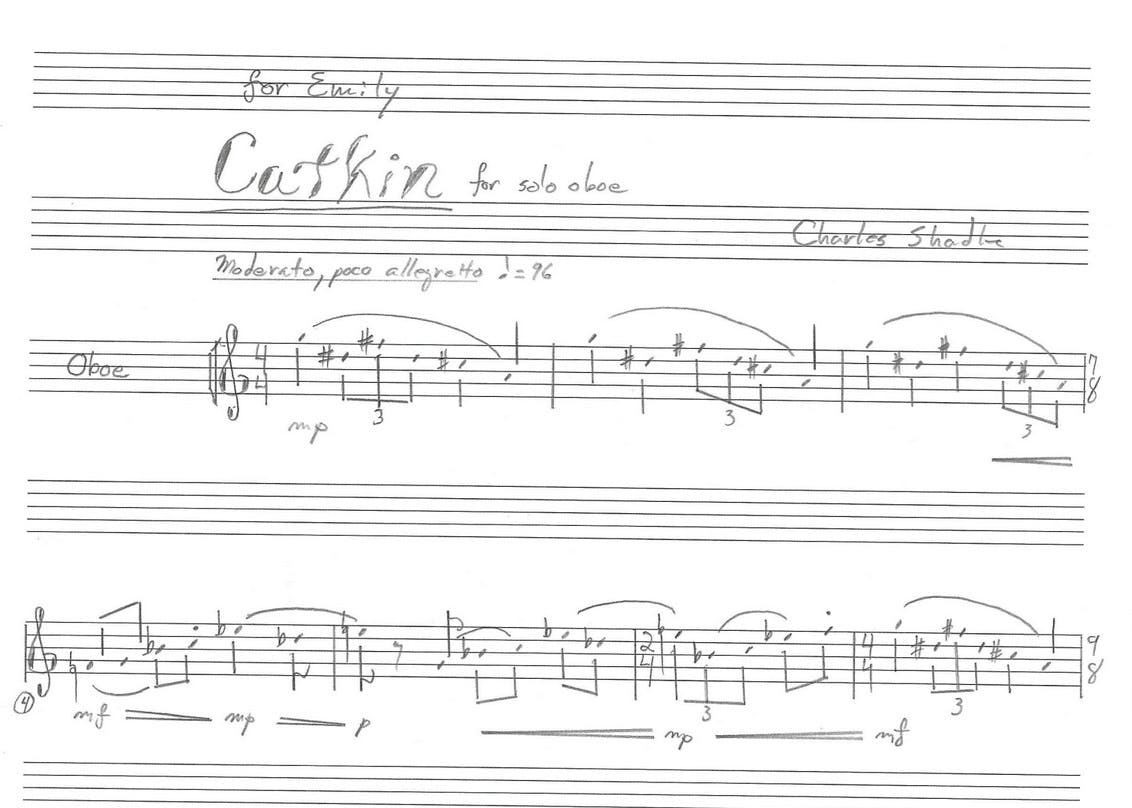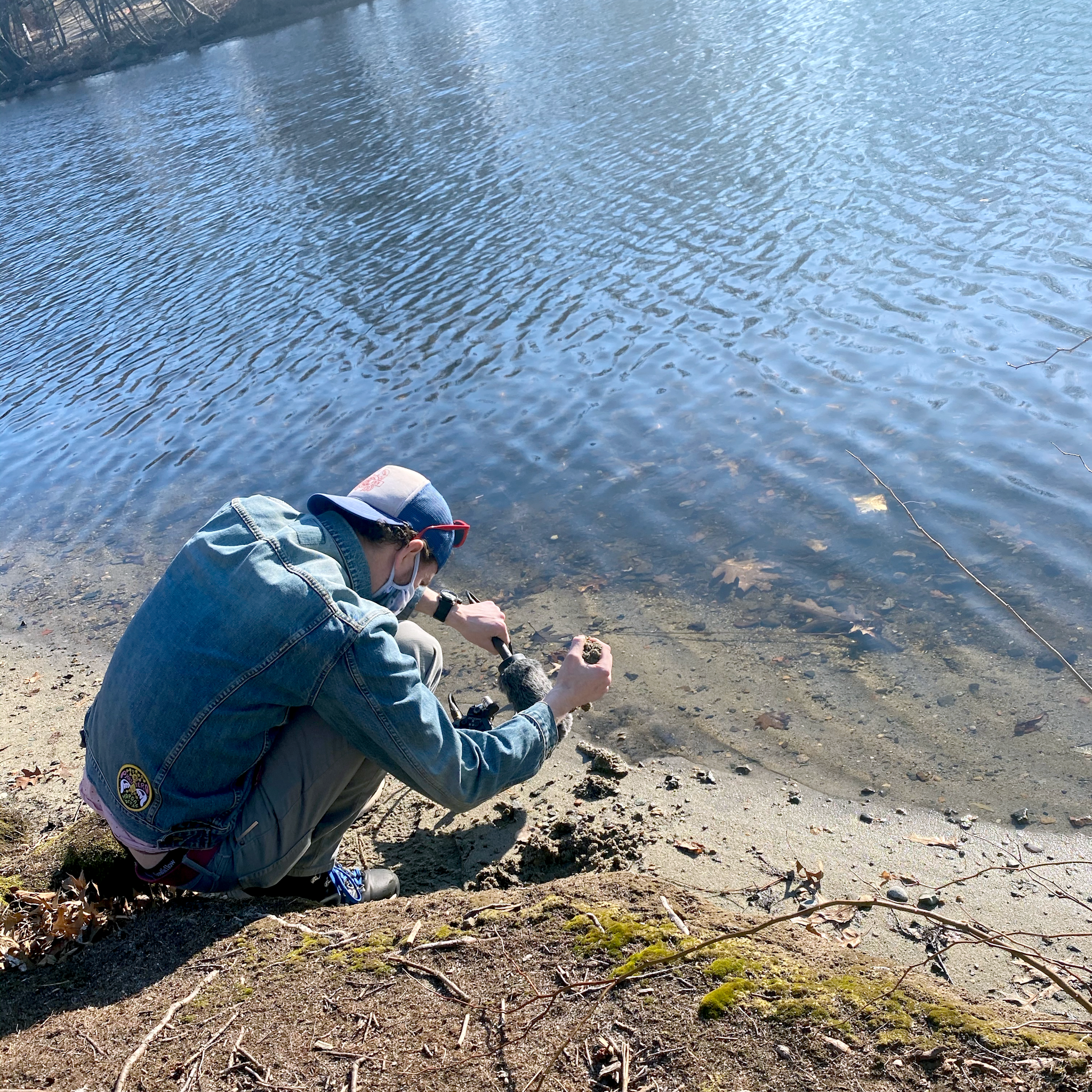Last spring as the reality of the pandemic set in, Charles Shadle started taking long, rambling walks for hours along the Mystic River. The senior lecturer in music at the Massachusetts Institute of Technology was working from home—a place he had never composed from before—and felt stuck. His regular walks along the river became an anchoring ritual and source for inspiration.
“I didn’t feel like I could write music,” Shadle said. “But along the river, I started to feel like I could work again. I’d see a cluster of leaves hanging on a tree, and I’d think, ‘A piece of music could look like that.’ I was turning inward, but the natural world was saying ‘no.’”
Shadle’s work is one of the fourteen pieces commissioned for Sound on Mystic, an outdoor audio installation that guides visitors along two miles of the Mystic River through site-specific sound pieces. To experience the installation, pop in a pair of headphones and download the free GPS-enabled ECHOES app. Like a scavenger hunt for sounds, the app autoplays pieces as you walk into their range along the river. The installation opens May 15 and runs from the Cradock Bridge in Medford Square to the base of the Mystic Lakes.
Listeners will find Shadle’s piece, titled “Catkin,” nestled in a quiet nook of trees beside the river. The composition is based on his observations of the natural world and is influenced by his Native worldview as an enrolled member of the Choctaw Nation of Oklahoma. The lilting solo oboe composition performed by Radius Ensemble founder Jennifer Montbach is interspersed with silences, allowing the sounds from the river to bleed in and become part of the aural experience. As the three-minute experience ends, it disappears into the natural world.
“[The Mystic] became an incredibly important part of my own life,” Shadle said. “The feeling like it was a survival strategy—I wanted to celebrate that. The river and the natural world going on and blooming, trees getting leaves, it felt like life continuing. And that meant I could start thinking about life continuing for me too.”
Although Sound on Mystic is an art experience perfectly suited to the pandemic, the idea was conceived before “social distancing” was a common phrase.
The project developed organically, flowing a bit like the river itself from ideation to its approaching open date. Its headwaters, if you will, sprung at a Medford Arts Council meeting in early 2020. Co-creator Ian Coss had recently moved to the area and introduced himself as an audio producer; Gary Roberts, the council’s former chair, and Dwayne Johnson, a current council member, were interested in collaborating to create a sound-based art installation.
“It just snowballed from there,” Coss said. When the pandemic closed concert venues, museums, and art galleries along with everything else, the team had a dawning realization of what the shutdown meant for art and artists.
“I think the project took on a new kind of urgency,” Coss said. “And that’s why we decided to launch it this spring, and work on it this winter, when obviously many performing artists didn’t have a lot of outlets for their work.”
Musicians, including the Thread Ensemble trio, Derek Hixon, who performs as Mint Pillow, and djeli and balafon (the West African antecedent of the xylophone) player Balla Kouyaté, all have pieces along the installation’s course.
In addition to musical works, the installation also features spoken word pieces, including Jazz Dottin’s “Petition,” which brings the words of Belinda Sutton to life not far from the Royall estate where she was enslaved in the late eighteenth century.
The Royalls were one of the largest slaveholding families in Massachusetts, and they absconded to England at the start of the American Revolution, leaving the people they enslaved in limbo. When Isaac Royall Jr. died, his will stated that Sutton could have her freedom and an annual payment of 30 pounds for three years.
“Massachusetts was not trying to do that,” Dottin said. In 1783, Sutton wrote the state a petition describing her experience and trying to get the money owed to her to live out the rest of her life, one of the first cases of reparations in the state.
Dottin first dove into Sutton’s story for an episode of her Black history video series, “Black Gems Unearthed.” Through the process of further engaging with the material for Sound on Mystic, she felt herself developing a relationship with the river and water more broadly, meditating on themes of the transatlantic slave trade and the movement of people and bodies.
Multidisciplinary artist Erin Genia’s “Continuity” also engages with history and how it is remembered and passed through generations. Her piece explores Rock Hill, a site where a small group of Indigenous people lived prior to the arrival of colonial settlers, by weaving in a conversation with her children.
Taken together, the installation provides a chance to reframe the waterway as a site for contemplation. For anyone who primarily experiences the Mystic as scenery while fighting traffic on the Mystic Valley Parkway, Sound on Mystic offers an opportunity to slow down and explore.
“Going by in a car is experiencing frustration, not the river,” Dottin said. “This is an opportunity to slow down and hear people’s interpretation of the river and the history of the area.”
The installation can be enjoyed as a complete compilation or individually. Either way, Coss notes, it’s not meant to be an informational tour. Rather, “each piece is its own little world.”
“It’s an invitation for serendipity,” Coss said. “We took fourteen artists with no connection to each other and gave them a common prompt, which is the river itself, and just said ‘Take your disciplines, your experiences, your interests, and create a five-minute sound experience.’”
For incoming Medford Poet Laureate Terry Carter, his experiences with the Mystic stretch from his childhood through the present. He grew up playing sports at Dugger Park, learned to fish along the river, and was taught how to swim at Sandy Beach.
“Those were rites of passage,” he said. “And it’s where West Metford always came together, right at the Mystic River, for July 4th celebrations, family picnics, basketball tournaments, all the things that communities do when they’ve got a strong and dynamic bond.”
Today, Carter directs elder services for the West Medford Community Center. He recorded his poem “Hard By the Mystic” along the banks of the river just across the street from his office. The poem describes the experience of African Americans settling in redlined West Medford and the community’s relationship with itself and the broader city.
“It’s a liberating message,” Carter said. “It’s about a certain kind of bondage that is overcome by the human spirit. It’s not slavery per se, but it’s confinement overcome again by folks banding together in determining that they were going to take what they were given and they were going to turn it into something beautiful.”
Other pieces explore the ecology of the river, like Joanna Hay’s work about river herring or Michael Dewberry’s woven sounds of human interaction with the natural environment.
“To me, audio is a way that you can create art about a place that also lets you experience that place at the same time,” Coss said. “It lets you be in the place. It lets you walk. It lets you see, lets you smell, lets you feel the air, while also getting this aesthetic experience alongside that.”
Like the melting of ice or the slow bloom of a flower, reopening after over a year of shutdown can feel fraught, but exciting. As Coss encouraged, smelling and feeling the air while diving into another auditory world sounds like the perfect way to awaken into spring. As we reconnect with the natural world, Sound on Mystic helps us remember it was here all along.
Sound on Mystic was created with funding from the Medford Arts Council and Arlington Cultural Council and support from the Mystic River Watershed Association.
To experience the installation, users can download the free ECHOES app through either the Apple or Android app store, and then search for “Sound on Mystic,” or use the following link to access the installation: soundonmystic.com. Once the app is downloaded on your phone, this link will give users the option to OPEN the walk in the ECHOES app.
Once you open the “Sound on Mystic” walk in the ECHOES app, it will show a map of the river with areas highlighted in blue. As soon as you enter a highlighted area, sound will automatically begin to play.


